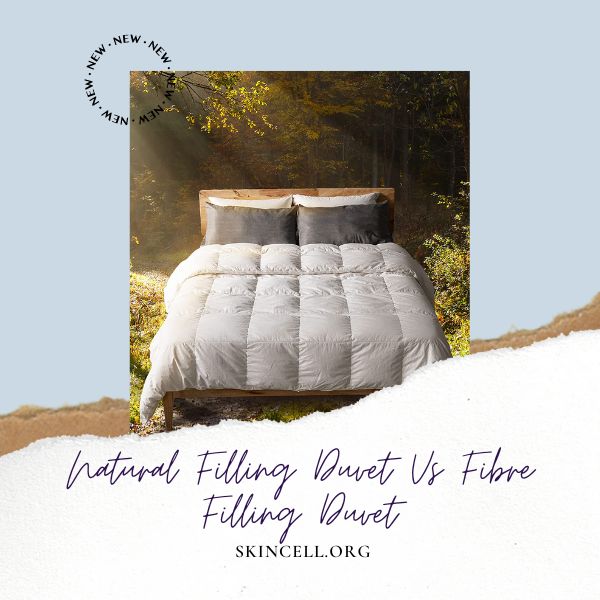With so many choices of duvet fillings available from silk, wool, feather, down and even bamboo, how is it possible to make the correct choice? How do you make your sleep environment allergy-free and stay warm the whole night?

Let’s dive in and discover some of the answers you are searching for.
What type of duvet do you need?
You are at a point where you will buy a new duvet, but what do you choose? The choice of fillings is enormous and to be honest, the price range is staggering, so what do you need? There are a few factors to consider when selecting a duvet filling.
Ok, let’s start with natural fillings:
- Wool. Wool is maybe the new kid on the block for duvet filling and a filling that you would not normally associate with a duvet. However, the wool-filled duvet has so many benefits, such as being allergy-free. It may supersede the more traditional duvets fillings. Medium priced
- Feather. If you are of a certain age, you may have been only too happy to see the back of your old feather duvet. Prickly feathers poking through the duvet was not the best idea for sleeping well. But feather duvets are back in fashion for a good reason. They are warm and luxurious. Medium priced
- Down. A more exclusive product than feather duvet fillers, down provides warmth and luxury. Mid to high-end price
- Silk. Could you really afford a silk-filled duvet? Well, the answer is yes you can. You can experience the luxury of the silk duvet and enjoy the whole experience of sleeping under an exclusive product. Expensive
- Bamboo. Your thoughts can be heard throughout the cosmo. Yes, bamboo is a duvet filler, and what’s more, if you have sensitive skin, this ubiquitous natural product may be the duvet for you. Medium priced
What do synthetic duvet fillers have to offer?
- Hollowfibre. If you have thoughts about sleeping on a cloud, then the hollow fibre duvet filler will make you feel like you are lying on top of a fluffy cloud, and you experience a lightweight, very warm duvet. Fits mots budgets
- Microfibre. You will be stunned by the microfibre duvet. It’s linked to sleeping under a down duvet, with its additional weight and silky feel. A real winner in the synthetic lineup. Affordable
What is the best material for a duvet inner?
It’s a personal choice. Personal choices are often driven by budget, so duvet fillers become a secondary consideration.
If you are not on a budget, you should look closely at a down-filled duvet. Down is soft and fluffy and will provide years of good use.
Down is the perfect medium for trapping air within the duvet that forms part of the tog rating or thermal insulation properties to keep you warm on the coldest nights.
If down is your preferred choice, then it would be remiss of you not to take a careful look at microfibre. Microfibre is often compared to down and feather duvet fillers.
Microfibre contains a very fine denier filling that is silky smooth and has excellent thermal properties like down feathers.
Microfibre duvets can be purchased at a fraction of the cost of purchasing a down duvet.
What is the best duvet for night sweats?
A breathable duvet filler is needed for a person who has night sweats. Natural fibres like down, feather, or even bamboo fillers are recommended if you sleep hot and tend to sweat at night.
Natural fillers are said to provide up to 4 times more airflow through the filler media than synthetic products.
The two best products are Hungarian goose down duvets for a breathable duvet to eliminate sweating while sleeping or Wool duvets fillers.
Duvets made from wool are incredibly versatile and provide a warm and breathable duvet experience to the user.
Microfibre is an alternative considering its breathable characteristics. Microfibre synthetic material is a good all-around substitute for natural duvet fillers and should be considered due to its feel and cost point.
Which duvet is best for winter and summer?
The duvet has a tog rating that suits you best. When talking about winter duvet fillers, you must talk about tog values.
A good all-season tog value is 10.5 regardless of the duvet filling.
Natural filler mediums have the advantage of being slightly weightier than synthetic fillers, adding a dimension of comfort and warmth.
Down is an obvious choice for warmth during the colder season, but you should not discount the use of wool as a natural filler for a duvet.
Everyone knows that wool has terrific insulation properties and plays an enormous role in our day-to-day clothing. Hence, it is hardly a surprise to think of it as an excellent duvet filler, and it’s hypoallergenic!
Do synthetic duvet filers make a good winter duvet? Yes, they are excellent at providing warmth and comfort through colder winter nights.
You can expect comfort and a toasty night’s sleep if you use hollow fibre as a duvet filler. However, it does tend to sleep on the hot side, so you may find yourself flicking the duvet off your body to cool down at times.
Microfibre duvets fillings. Microfibre is the exception to the rule. Microfibre offers many of the benefits of natural duvet fillers. It breathes, it’s more weighty than its other synthetic filler counterparts and feels like a premium down duvet.
Which duvet filler is best for you?
Suppose you have allergies, and the selection criteria narrow to synthetics and wool. If you have a tight budget, head straight for the microfibre duvet, it’s a great value and feels special.
Hungarian down would be a great place to start your search if you are not constrained by budget. It’s rated as the best duvet filler for good reasons. Soft, warm and longevity are just a few reasons you might select this duvet.
 Nectar Mattress
Nectar Mattress 


